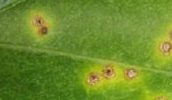
Bacterial spot is caused by several species of Xanthomonas, most commonly X. perforans, and is more prevalent in warm (75-86 F) humid climates with frequent rainfall (or overhead watering). The bacteria enter through natural openings (like stomates) or mechanical injuries and may affect the leaves, stems, and fruits. Bacteria are easily spread by water and may overwinter in infected plant debris. Infection of leaves begin as small (less than 1/8″ wide) circular water-soaked areas that may be surrounded by a faint yellow halo. Although initially yellow green, the lesions darken to reddish brown, dry out, and often tear. Alternatively, extensive yellowing and leaf loss may occur. Spots on the fruit are usually brown, raised, scabby, 1/4 across, and may have a waxy white halo. Spots on the stem are usually circular and dark brown to black. Photo Credit Wikipedia
Control:
- Remove infected plants and dispose of them outside the planting area
- Avoid overhead watering by using drip irrigation or soaker-hoses.
- Wash tools, hands, and clothing that may carry the disease.
- Avoid working with wet plants.
- Use a 3 year crop rotation scheme with crops from other plant families
- Remove volunteer plants as they may carry the disease.
- Prune plants to improve air circulation.
- Remove all plant debris at the end of the season and dispose of it outside the planting area.
- Use resistant varieties
- Consider using preventative applications of copper-based products as recommended by your County Extension agent.